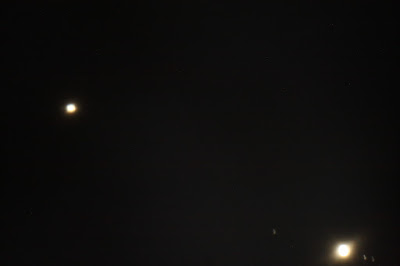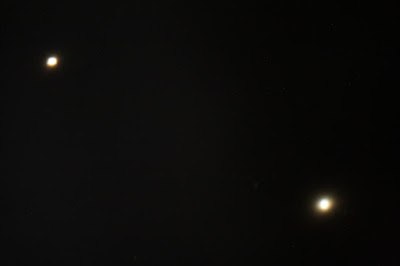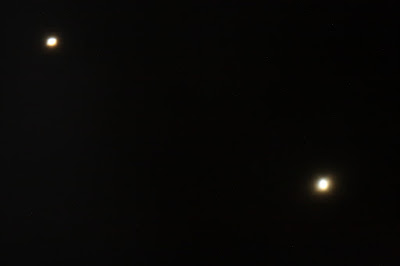Around 4:15 or 4:30. I wasn't convinced the skies would be really clear when I saw a bunch of cirrus feathered clouds on high and low thick clouds over the western horizon. From the driveway I spotted the crescent Moon. Couldn't see the planets.
Went indoors to check the weather websites. The cloud bank was hovering just to the west, wiggling back and forth. But then I thought, "you don't want to miss this."
When I returned outside with the eyepiece case, things had improved! Yes!
Quickly set up the Celestron 8" Schmidt-Cassegrain Telescope atop the Vixen Super Polaris supercharged with the IDEA GoToStar system on the levelled tripod. Installed the baader planetarium aspheric 36mm ocular. Installed the finder scope. As I hooked up the heavy-duty extension cord, I bumped into Rhonda. Energised the mount and aimed at the planets.
Oh. My. Universe.
Saturn and Jupiter in the same field of view! It was awesome!
Shared the view.
I explained the historical significance of the event. We were among the first humans ever viewing with magnification or photographing these planets so close together.
Exhilarating. Good detail on Jupiter. Only three moons though. I knew the distant one was Callisto. I wondered if the bright one was Io. Could see a big barge near the meridian.
Saturn and its rings were lovely. As the sky darkened, Titan emerged, beyond the east edge of the rings, toward Jupiter.
Rhonda asked me how far apart the planets were in space. I didn't know the numbers off the top of my head and we cancelled the huge download update for SkySafari Plus on her phone. I said it was significant, millions of kilometres. [ed: Jupiter is 5.9 AU (Astronomical Units) from the Earth or 882 million km; Saturn's distance is 10.8 AU or 1.615 billion km. The difference is 732 million km.]
We talked about the brightness. I gathered she had read something that said the planets would be incredibly bright in the sky on the 21st. Ah. No. Only slightly brighter than Jupiter was currently... [ed: On Dec 21 at 6:00 PM for Ontario, Jupiter and Saturn's extincted magnitude values will be, respectively, -1.17 and 1.43. I calculate the combined mag at -1.3.]
What an amazing sight in the 1° field of view. Wow.
The seeing was fair, not as bad as I thought it was going to be.
I was a little surprised how far apart the planets were in the sky. A pinkie fingernail. To the right of the Moon and down slightly. A beautiful scene. Magnificent earthshine.
Fetched the camera to do a test shot but before hooking it up, I swung to the Moon. Crisium was on the terminator. It made the uneven lava flows in the maria floor very obvious. Along the north pole, there were two isolated white dots, mountains peaking into the sunlight. Long shadows everywhere.
Grabbed the t-ring and nosepiece.
Installed the camera and focused moving the primary. Fine-tuned with the Williams Optics Crayford type focuser. Tagged Saturn. Hunted around and bumped into Jupiter. Rotated the camera and panned some more. Wait! What! There they are! I couldn't believe it when I saw both on the sensor. But they were faint on the live view... Decided to take a shot.
Common camera settings. C8, f/10, external focuser, manually focused, tracking, not polar aligned, Canon 40D, ISO 1600, 10 seconds, in-camera long exposure NR off, daylight WB, RAW, manually triggered, 2 second self-timer. For all, north is up, east is left.
Converted with DPP 4.6.10.0. Not processed.
[ed: Callisto is between Saturn and Jupiter. The bright moon to the right is Ganymede. The outlier is Europa. Io hidden... Jupiter distance from the Sun: 33° 21'. Jupiter from Saturn: 26' 12". Jupiter's altitude above the horizon: 10° 59'.]
Panned a smidgen.
Wow. What a sight. A big one for the life lists...
Not that cold. Low humidity.
Remembered to polar align before tearing down. OK. So that was an excellent test session. Optically, everything is fine, planets are "in range" of the camera, I'm in a good spot on the lawn, and the Vixen is polar aligned. I'll be ready for the next clear night!
Wow. Very happy I pushed through the laziness.
"Witness me!"
"Historic!"





No comments:
Post a Comment